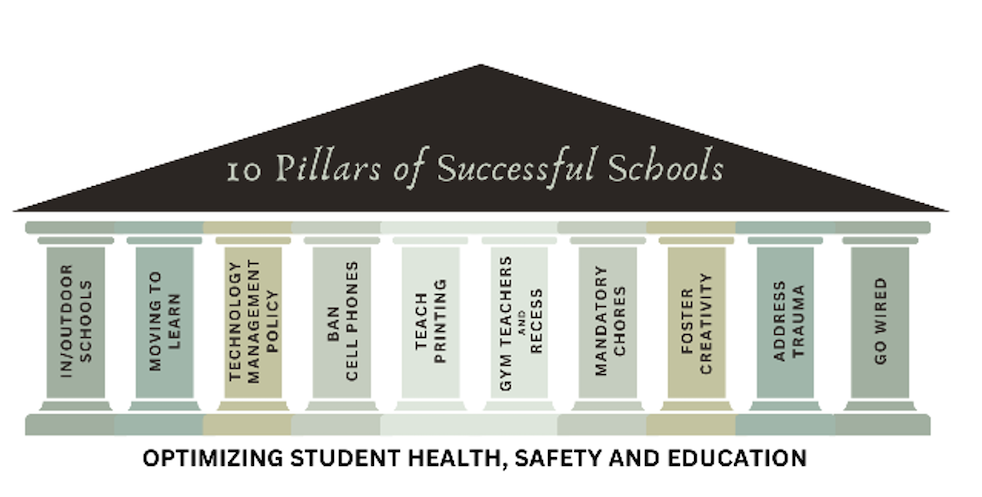The onslaught of screens in homes and schools has resulted in significant negative outcomes for students, teachers and parents indicating the need to push the ‘tech pause’ button for reflection and planning. Students are more sedentary and unfit resulting in delays in development, poor health and failed literacy. Screens are overstimulating to eyes, heart and brain causing visual impairment, cardiovascular damage and attention deficit. Screen use is isolating students from what they yearn for the most, human love and connection resulting in soaring rates of anxiety, depression, and suicide in children and youth. Screen overuse by parents and teachers is causing a ‘disconnect’ in students resulting in a host of emotional, mental, and social disorders. Children and youth have never been sicker than they are now and the time to act is passing us by. A 2021 study reported that setting and monitoring screen time limits, discussing impacts of screen use, taking frequent breaks, incorporating movement throughout the day, encouraging adults to practice healthy screen use and tapering screen use are effective measures to reduce harmful effects of screentime on children and youth. These recommendations mandate schools form not only technology management policy to address declines in student health and wellbeing, but also enact media literacy programs. The Ten Pillars of Successful Schools was written by pediatric occupational therapist and child development expert Cris Rowan to help schools navigate their way out of this ‘virtual hole’. This article offers 10 research evidenced and strategy focused initiatives which if acted upon quickly, could show positive outcomes of less problematic behaviors, improved physical fitness, greater motivation, and improved grades prior to school year end July ‘23. Funding for these initiatives is two-fold: immediately stop all purchase of technology products (programs, devices, apps) and consider school district litigation against tech industry for causing irreputable harm to students; proceeds to go toward healthy alternatives e.g. playgrounds, equipment, books, counselling.
Numerous studies show improved attention, learning and behavior in outdoor school settings and declining academic performance with school screen use. Yet despite research evidence favoring outdoor schools, education governments continue to ignore health guidelines and mandate schools toward online learning. While many schools are not set up for outdoor concepts, a transitionary step would be for each classroom to split into two groups with two teachers. Half of the students would remain inside for half the day while the other half are outdoors with a midday switch. Children have a right to go to school to not only learn but be able to socialize with their friends. Termed In/Outdoor Schools by author, this concept would not only enhance student health and learning, but also would be a pandemic prevention measure. Investing in in/outdoor school concepts would be a win-win for everyone hands down.
Whether in the classroom, gym or on the playground, students should be allowed liberal access to movement. The 24-Hour Canadian Movement Guidelines state that kids should be sweating for 1 hour per day, stepping for 2 hours/day, not sitting for more than 2 hours/day and not using screen technology for more than 2 hours/day. Physical exercise is linked to seven different types of cognitive performance: perceptual skills, intelligence quotient, achievement, verbal tests, math tests, developmental level, and academic readiness. In classrooms students should use standing, treadmill or elliptical desks, have frequent ‘body breaks’ to either wake up or calm energy states, and have access to a variety of Moving to Learn tools and techniques to get their energy in the zone to learn. Gyms should be open before/after school and recess and outfitted with obstacle courses, climbing walls, loud music, and organized games. On playgrounds, provision of loose play equipment has a proven substantial increase in moderate to vigorous activities in under 6 months. The popular “Every day is an outside day” policy will exponentially improve desired outcomes. See author’s blog movingtolearn.ca for extensive, additional information.
Schools are all over the map regarding screen rules with some teachers practicing tried and true ‘low tech’ teaching methods and others practicing ‘tech centric’ teaching. High tech teaching uses both non-evidenced based edtech and entertainment tech liberally, even allowing students to remain inside during lunch watching cartoons or movies. Most schools haven’t a clue what teachers are using in the realm of screen duration and content and many parents report schools are not responsive to their requests for non-screen instruction as the curriculum heavily relies on apps and phones. Use of screens as rewards is prevalent in schools despite research showing worse behaviour afterward (short-term gain, long-term pain). Education technology is not research evidenced and is industry driven, creating huge conflict of interest. 96% of educational apps harvest and share student data creating long-term privacy and safety issues for all students.
Teachers universally state they do not want to ‘police’ student’s cell phone use. Inconsistent rules between teachers regarding cell phones in classrooms, result in student confusion and non-compliance. Using cell phones to access education content while possible, is not plausible as most students do not have the requisite self-control (nor do many adults). Unrestricted use of cell phones is not safe for multiple reasons, most notably exposure to harmful content including social media, cyberbullying, violent video games and pornography. Cell phones are sedentary, isolating, addictive, distracting, promote cheating and are causing rising rates of anxiety, depression and suicide. If teachers were told that there was one initiative they could enact immediately that would improve student behavior, attention, ability to learn, academic performance, motivation, literacy, physical fitness, mental health and social ability…you’d think they would jump on it. Many progressive schools are now banning cell phones and along with the phone goes all the harmful content, teacher phone management headaches, leaving loads of time left for actual learning to take place. It’s time for technology production corporations to fund physical school supplies such as books in leu of pervasive damage they have caused.
Screens cannot teach literacy. The foundations for printing, reading and math are 3-dimensional requiring motor proficiency, spatial concepts and cognition. Early and overuse of screens in schools has displaced research evidenced, known to be effective teaching methods and subsequently eroded foundations for literacy resulting in average 2-year delays following Covid. Primary teachers printing instruction has fallen to an ineffective 13 min. per day and consists mainly of worksheets, yet students are expected to perform printing output multiple times per day. Students who are taught to print properly using strategy focus and repetition, gain a ‘visual memory’ of the letter/number and a ‘motor plan’ allowing them to print subconsciously, freeing their mind up for higher level learning e.g. reading. Students who receive insufficient printing instruction struggle in every subject as they laboriously try to remember how to make their letters and numbers. The motoric and spatial aspects gained during printing practice are foundational to reading and math. Students should not be using any screens (edtech or entertainment) until grade 3 printing, reading and math literacy is achieved.
Over the past 35 years, the author has witnessed an erosion of gym teachers in primary and elementary school settings, as well as a decimation of recess across the board. The results are devastating. Participaction Canada in 2022 released it’s annual report card for children and youth, giving them a D- for active play and an F for sedentary behaviors. With children using 7.5 hours/day and teens 9 hours/day of entertainment-based screens at home, schools are in a default position to promote healthy physical activity whenever possible. Relying on classroom teachers to add physical education and recess monitoring to their long list of curriculum requirements, is not adequately meeting student movement needs. Gym teachers offer valued expertise and knowledge to provide a variety of physical activities and fitness programs which can be carried out in both gym and playground environments. Recess while mandated by education ministry, does not in and of itself achieve increased movement. Recess requires leadership from older students or gym teachers to engage students to get up and move. AAP policy statement says safe and well-supervised recess offers cognitive, social, emotional, and physical benefits that may not be fully appreciated when a decision is made to diminish it. Recess is unique from, and a complement to, physical education—not a substitute for it. The American Academy of Pediatrics believes that recess is a crucial and necessary component of a child’s development and, as such, it should not be withheld for punitive or academic reasons. Ask your technology corporation providers to fund a new playground, obstacle course or fitness equipment to get kids moving and learning.
The premise of occupational therapy is that human mental and physical health improves when accessing tasks that are purposeful and meaningful. Competence and confidence grow when engaged in an activity which is valued, of interest and within the perceived skill set of the student. Low (or no) expectations by teachers of students result in apathy and disengagement. Humans are pack animals and for children, their packs are comprised of their family and classroom. 100 years ago, children grew up in hunter, gatherer or farming society structures where they were required to do specific jobs everyday to survive. Today’s child has few expectations or chores, resulting in lack of purpose and meaning which can lead to depression and suicide. Every student should have one task they are expected to do everyday for their classroom or school, and if they fail to do this task, should think that their pack will not survive. Suggestion is for every classroom to have a chart of chores to be performed on a daily basis and if the student fails to do their chore, the result is feigned ‘collapse’ of the classroom milieu. Have fun with this initiative…it can be life changing for some children.
Creativity requires both divergent thinking (generating loads of unique ideas) and convergent thinking (combining those ideas into best result). Jean Twenge found in her research that after only one hour of screen time, children show significantly lower curiosity and creativity. Screen use kills creativity. Due to the constant ‘spoon feeding’ thru search engines such as google, today’s student lacks originality and opinions, which have been negated to what they like, dislike or share. AI programs including ChatGPT have made plagiarism the norm and further eroded creativity and originality. Grades and teacher expectations became irrelevant during Covid creating a heightened state of student anxiety. Sir Ken Robinson stated that if children are not prepared to be wrong, they will never come up with anything original. By stigmatizing mistakes, schools are educating children out of creativity. The typical education hierarchy of top: math, language, mid: literature and bottom: arts, music, dance and drama, appears to be raising kids to be university professors. Peter Gray states in his article “Kids want to cooperate, but we make them compete” that children are natural learners, that they continuously explore the world around them, and they cooperate in these activities. They explore together and excitedly share their discoveries. But in school, where adults are in charge, it’s all about competition, motivated by rewards and praise for winners and demerits and shame for losers. Who can get an A, make the honor role, score in the highest percentile on a test? This destroys the fun of discovery, learning and creativity. A 2010 IBM Global CEO study identified ‘creativity’ as the most crucial factor for future success, yet schools continue to focus on math and language and fail students who don’t meet set benchmarks. What would schools look like if they were fostering creativity and educating students for success?
As teachers and parents connect more and more to screens, they are disconnecting from children with horrific results. Neglected children in the absence of human connection are as a default forming unhealthy attachments and addictions to screens. Johann Hari in his book Stolen Focus states “The opposite of addiction is connection” indicating the need for teachers to serve in the role of secondary attachment figures in their student’s lives. As adults fall deeper into the ‘virtual void’ of screen addiction, their ability to provide children with critical foundations for growth and success decline. Child abuse, neglect and trauma is increasing, necessitating teachers to have a ‘trauma informed lens’ and trauma training when working with children. Peter Levine in his book Trauma Through a Child’s Eyes states “Trauma is perhaps the most avoided, ignored, belittled, denied, misunderstood and untreated cause of human suffering.” Teachers are referring children with problematic behaviours who have underlying trauma to the medical system for diagnosis and medication. It’s not the child who has the problem, but rather it’s the systems that surround the child that need to change. Use of time outs, body breaks, and creation of chill out spaces for calming are urgently needed in today’s schools. Children with trauma need to be seen and heard, listened to and not judged, and provided with environments conducive to play, feeling safe, and learning.
Wireless radiation has not been proven safe with numerous studies proving harm. Why then are there no government safety guidelines? Many schools, as well as many countries, have made the move to ban wireless radiation from environments that house children and youth. The American Academy of Pediatrics recommends restricted use of cell phones stating “They’re not toys. They have radiation that is emitted from them and the more we can keep it off the body and use (the phone) in other ways, it will be safer,” said Jennifer A. Lowry, M.D., FAACT, FAAP, chair of the AAP Council on Environmental Health Executive Committee. Schools can effectively remove wireless radiation and protect students and teachers by creating ethernet plug-in stations. Banning cell phones is a no-brainer.
Ten Pillars of Successful Schools was written in April 2023 by pediatric occupational therapist, biologist, author, and speaker Cris Rowan. Cris’s website is Reconnect Webinars, blog is Moving to Learn and book is Virtual Child. Cris can be reached at info@reconnectwebinars.com. Supporting information regarding the proposed Ten Pillars of Successful Schools can be found in Reconnect Webinars – Child Development and Technology Management series.




